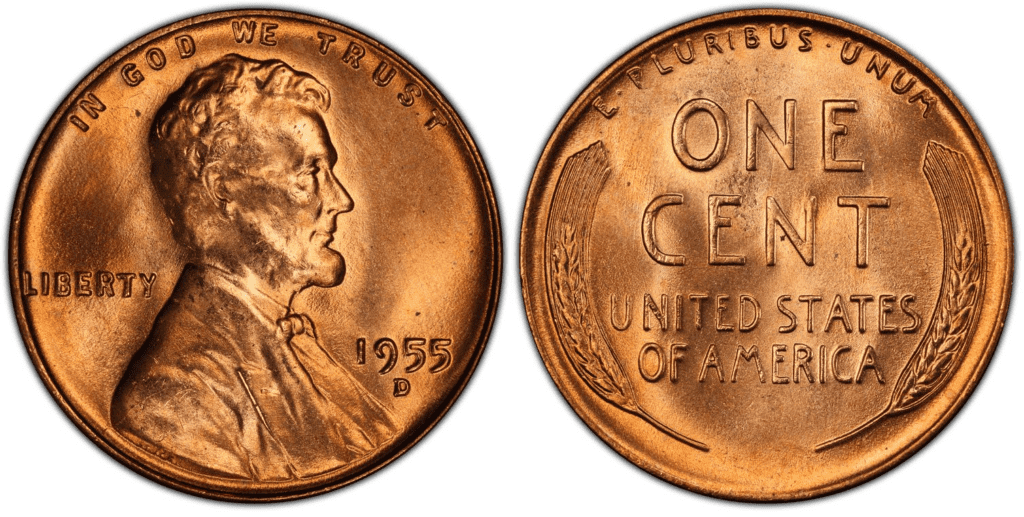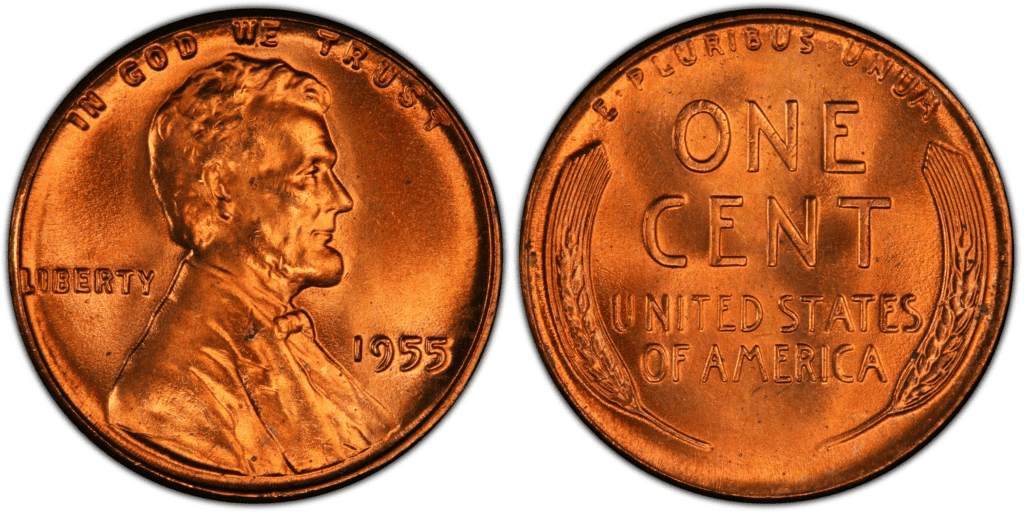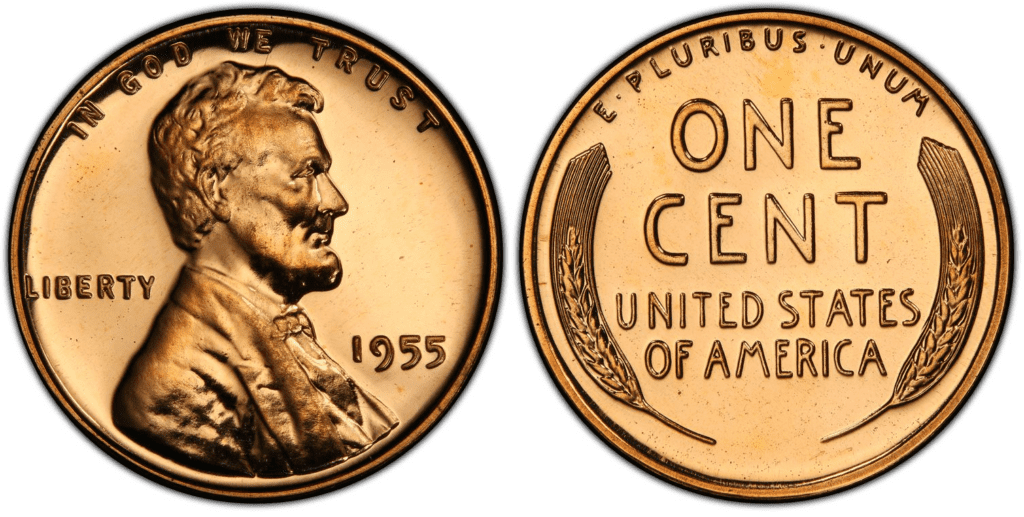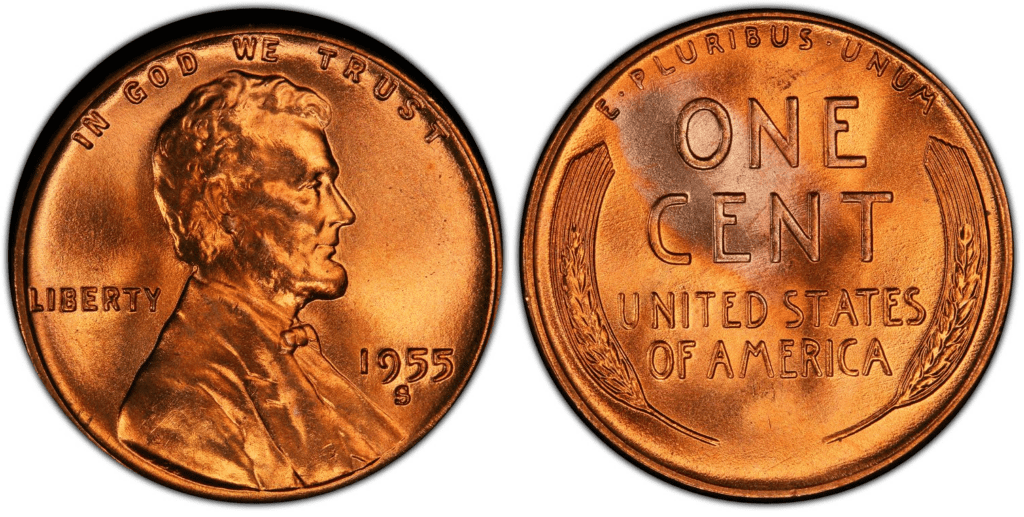The US Mint has been producing the Lincoln penny for more than 100 years, and is being issued even today. With that in mind, there’s no doubt that old Lincoln pennies are more valuable than modern pennies.
As time goes by, the value of pennies increases. Also, wheat pennies are even more valuable because they are older than the ones with the Lincoln Memorial on their reverse.
The 1955 wheat penny is made of 95% copper, 5% tin, and zinc. In 1943, the penny was made with zinc-plated steel, which made a truly unique year for the 1-cent coin. From 1909 to 1942 and from 1944 to 1982, the penny was made with copper, tin, and zinc. It was in 1982 up to the present that the penny transitioned to 97.5% zinc and 2.5% copper.
The Lincoln penny was first struck in 1909. Victor David Brenner prepared the original design. He designed both the obverse and the reverse side of the coin. The reverse featured two stalks of wheat, thus the nickname “wheat penny.” However, by 1959, the wheat was replaced by the Lincoln Memorial.

The design of the 1955 Lincoln penny was relatively simple. It has the image of Abraham Lincoln facing to the right side. Inscriptions include IN GOD WE TRUST, LIBERTY, and 1955.
On the reverse side, you have the two stalks of wheat engraved on the left and right sides. You then have the inscriptions, which include E PLURIBUS UNUM, UNITED STATES OF AMERICA, and ONE CENT.
In 1904, the President at that time, Theodore Roosevelt, asked Leslie Mortier, the Secretary of the Treasury, to make some improvements to the US coins. According to Roosevelt, US coins lack an artistic look and must be changed.
That was when Mortier asked Augustus Saint-Gaudens to redesign the cent. Unfortunately, at that time, Saint-Gaudens was already sick with cancer. Regrettably, he didn’t finish the design for the cent. Thus, Brenner was tasked to complete the design.
1955 Lincoln Wheat Penny Varieties
The 1955 Lincoln penny varieties include four original designs. These are the 1955 P, 1955 D, 1955 proof, and 1955 S pennies. A total of 938,825,700 1-cent pennies were produced in 1955.
Aside from the standard struck pennies, some error coins sporadically appear due to minting errors.
Here are the 1955 Lincoln penny varieties you should know:
1955 D Lincoln Penny
Edge: Plain
Mint Mark: D
Place of minting: Denver
Year of minting: 1955
Face Value: $0.01 (one cent)
Price: $0.01 to $8.00 (or more)
Quantity produced: MINTAGE: 563,257,500
Designer: Victor D. Brenner
Composition: 95% copper and 5% zinc and tin
Mass: 3.11 grams
Diameter: 19.05 mm
Thickness: 1.52 mm

photo source: PCGS
The Denver Mint produced more than 563 thousand 1955 D pennies, which is the highest mintage for this penny series.
The price range of the 1955 D penny is $0.01 to $8.00. While thousands of 1955 D pennies are produced, most are now damaged. That’s why you would have difficulty finding these coins in uncirculated conditions. The 1955 D penny became rare when it reached MS66 and higher grades.
1955 P Lincoln Penny
Edge: Plain
Mint Mark: None
Place of minting: Philadelphia
Year of minting: 1955
Face Value: $0.01 (one cent)
Price: $0.01 to $6.00 (or more)
Quantity produced: 330,058,000
Designer: Victor D. Brenner
Composition: 95% copper and 5% zinc and tin
Mass: 3.11 grams
Diameter: 19.05 mm
Thickness: 1.52 mm

photo source: PCGS
The Philadelphia Mint produced more than 330 million Lincoln pennies in 1957. Circulated and uncirculated 1955 pennies can fetch between $0.01 to $7. Unfortunately, like most of the coins produced by the Philadelphia Mint, the 1955-P penny doesn’t have a mint mark.
What’s worth noting about the 1955 wheat penny is that the quality control at that time was inferior. Because of a very tight budget, the three Mints, especially the Philadelphia Mint, were forced to use even severely worn dies.
This is the main reason that in 1955, many people were encouraged to save their beautiful 1955 P pennies because they would surely be worth a lot of money in the future.
1955 Lincoln Penny (Proof)
Edge: Plain
Mint Mark: None
Place of minting: Philadelphia
Year of minting: 1955
Face Value: $0.01 (one cent)
Price: $1.00 to $17.00 (or more)
Quantity produced: 378,200
Designer: Victor D. Brenner
Composition: 95% copper and 5% zinc and tin
Mass: 3.11 grams
Diameter: 19.05 mm
Thickness: 1.52 mm

photo source: PCGS
Proof coins are specially made with extra care. That’s why, if you compare the 1955 wheat penny-proof coins to other varieties, it usually has the best luster, detail, and color.
The Philadelphia Mint produced 378 thousand proof coins in 1955, which was very low compared to the mintage of the following year. Nevertheless, the 1955 penny-proof coins are actually among the most common proofs in the wheat cent series. PR68, PR69, and PR70 are tough to find.
The price of the 1955-proof penny can easily reach $17.
1955 S Lincoln Penny
Edge: Plain
Mint Mark: S
Place of minting: San Francisco
Year of minting: 1955
Face Value: $0.01 (one cent)
Price: $0.01 to $12.00 (or more)
Quantity produced: 44,610,000
Designer: Victor D. Brenner
Composition: 95% copper and 5% zinc and tin
Mass: 3.11 grams
Diameter: 19.05 mm
Thickness: 1.52 mm

photo source: PCGS
The San Francisco Mint produced more than 44 million wheat pennies in 1955. Price may range from $0.01 to $12. With a large mintage, the 1955 S penny can easily be found in circulation today. However, 1955 S pennies in MS65 to MS66 are relatively scarce. Some examples with MS67 and MS68 should also be available but difficult to find.
List of 1955 Lincoln Penny Errors
With almost 1 billion 1955 Lincoln produced, it is not difficult to imagine that there will be error coins.
Perhaps, the most commonly identified error in the 1955 series of Lincoln penny would be the doubled die obverse (DDO) error.
In this error, the die hit the planchet twice, leaving a doubled effect on the engraved elements. Not all DDO errors are prominent. Some of them can be difficult, and you might even need a magnifying glass or microscope to find them.
Here’s what the DDO error looks like:

photo source: PCGS
Some of the most expensive 1955 pennies have the DDO error. The more prominent the error is, the more expensive it becomes.
To give you an idea, a 1955 wheat penny with a doubled die error was sold for $114,000 in March 2018 by Stack’s Bowers.
If the doubled die error is in the reverse, it is called DDR. Moreover, other errors affected the 1955 wheat Lincoln pennies. Here are the examples:
- Off-center strikes
- Weak strikes
- Strike-through
- Broadstrikes
- Clipped or folded planchets
- Blank planchet
How Much Is The 1955 Lincoln Wheat Penny Worth Today?
The 1955 Lincoln Wheat penny is worth 1 cent, as its face value shows. Its melt value is $0.0253. If your penny is in Average Circulated (AC) condition, you might as well get 18 cents from it. Certified pennies could bring you as much as $22.
You are probably correct if you think that’s not a lot of money. However, you would be surprised how some 1955 Lincoln pennies are worth astronomically a lot compared to their face value or melt value.
Here’s a 1955 Lincoln Wheat Penny values chart to help you know its pricing:
| Coin | Condition | Grade | Mintage | Value |
| 1955 D Lincoln penny | Circulated/mint | Not graded | 563,257,500 | $0.01 to $0.18 |
| 1955 D Lincoln penny | Uncirculated/mint | MS-65 | 563,257,500 | $10 to $27 |
| 1955 D Lincoln penny | Uncirculated/mint | MS-66 | 563,257,500 | $10 to $53 |
| 1955 D Lincoln penny | Uncirculated/mint | MS-67 | 563,257,500 | $216 to $1,140 |
| 1955 P Lincoln penny | Circulated/mint | Not graded | 33,058,000 | $0.01 to $0.18 |
| 1955 P Lincoln penny | Uncirculated/mint | MS-65 | 33,058,000 | $10 to $35 |
| 1955 P Lincoln penny | Uncirculated/mint | MS-66 | 33,058,000 | $22 to $223 |
| 1955 P Lincoln penny | Uncirculated/mint | MS-67 | 33,058,000 | $312 to $840 |
| 1955 Proof Lincoln penny | Circulated/proof | Not graded | 378,200 | $0.01 to $17.00 |
| 1955 Proof Lincoln penny | Uncirculated/proof | PR-67 | 378,200 | $14 to $306 |
| 1955 Proof Lincoln penny | Uncirculated/proof | PR-68 | 378,200 | $63 to $122 |
| 1955 Proof Lincoln penny | Uncirculated/proof | PR-69 | 378,200 | $121 to $159 |
| 1955 Proof Lincoln penny | Cameo | PR-68 | 378,200 | $404 to $1,880 |
| 1955 Proof Lincoln penny | Deep Cameo | PR-69 | 378,200 | $1,840 to $7,050 |
| 1955 S Lincoln penny | Circulated/mint | Not graded | 44,610,000 | $0.01 to $0.18 |
| 1955 S Lincoln penny | Uncirculated/mint | MS-66 | 44,610,000 | $18 to $95 |
| 1955 S Lincoln penny | Uncirculated/mint | MS-67 | 44,610,000 | $71 to $173 |
| 1955 S Lincoln penny | Uncirculated/mint | MS-68 | 44,610,000 | $7,475 |
As you can see, some 1955 wheat pennies are valued in the thousands. To further give you an idea of how much a 1955 Lincoln penny can be, check out these auction records for each variety:
- $114,000 – 1955 1C Doubled Die Obverse, RD (Regular Strike) with MS65+RD grade
- $14,950 – 1955 1C, DCAM (Proof) with PR68 grade
- $8,625 – 1955 1C, RD (Regular Strike) with MS67 grade
- $7,475 – 1955-S 1C, RD (Regular Strike) with MS68 grade
- $7,050 – 1955-D 1C, RD (Regular Strike) with MS67 grade
How Does The Grading System Work?
The Sheldon Scale is used by numismatists to provide a numerical value to coins. The Sheldon Scale goes from poor (P-1) to perfect mint state (P-1) (MS-70). Coins were originally evaluated using words to reflect their condition (Good, Fair, Excellent, Etc.). Unfortunately, coin collectors and dealers had different ideas about what each of these terms represent.
Professional numismatists joined together in the 1970s and established CoinGrading standards. These numismatists now assign grades at key places on the seventy-point scale, using the most regularly utilized numeric points in conjunction with the original adjective grade. The following are the most common coin grades:
-
-
- (P-1) Poor – Indistinguishable and probably damaged; if used, must have a date and mintmark; otherwise, rather battered.
- (FR-2) Fair – Nearly smooth, but without the damage that a coin graded Poor often possesses. The coin must have enough detail to be identified.
- (G-4) Fair – Inscriptions have merged into the rims in some areas, and important elements have been mostly erased.
- (VG-8) Very Good- A little weathered, but all of the primary design elements are visible, albeit faintly. There is little if any, central detail left.
- (F-12) Good – The item is very worn, yet the wear is even, and the overall design details stand out clearly. Rims are almost completely isolated from the field.
- (VF-20) Very Fine – Moderately weathered, with some finer features still visible. The motto or all letters of LIBERTY are readable. Both sides of the coin have entire rims that are separated from the field.
- (EF-40) Extremely Fine – Gently used; all gadgets are visible, and the most important ones are bold. The finer details are bold and clear, however, light wear may be seen.
- (AU-50) Uncirculated – Slight evidence of wear on the coin’s design’s high points; may have contact marks; eye appeal should be adequate.
- (AU-58) Uncirculated Choice – Slight traces of wear, no severe contact marks, almost full mint shine, and great eye appeal.
- (MS-60) Mint State Basal – Strictly uncirculated; no indication of wear on the coin’s highest points, but an unsightly coin with reduced luster, visible contact marks, hairlines, and other flaws.
- (MS-63) Mint State Acceptable – Uncirculated, but with contact scratches and nicks, little reduced shine, but otherwise appealing appearance. The strike is weak to average.
- (MS-65) Mint State Choice – Uncirculated with great mint shine, very little contact blemishes, and exceptional eye appeal. The strike is unusually severe.
- (MS-68) Mint State Premium Quality – Uncirculated with superb luster, no obvious contact marks to the naked eye, and exceptional eye appeal. The strike is quick and appealing.
- (MS-69) Almost Perfect Mint State – Uncirculated with perfect brilliance, a sharp and appealing strike, and extremely good eye appeal. A near-perfect coin with minor imperfections in the planchet, strike, and contact markings (seen only under 8x magnification).
- (MS-70) Mint State Perfect – Under 8x magnification, there are no tiny imperfections discernible; the strike is crisp, and the coin is perfectly centered on a beautiful planchet. Rarely seen on a coin, this coin is bright and whole, with original luster and exceptional eye appeal.
-
Where To Buy Or Sell 1955 Lincoln Wheat Penny?
You can buy or sell 1955 Lincoln wheat pennies online and offline. Many websites today will quickly give you results for the coin you’re looking for today.
You can go to Google and type “Buy 1955 Lincoln wheat penny” or “Sell 1955 Lincoln wheat penny.” You should then instantly get hundreds of relevant results.
Aside from the Internet, you can visit coin shops, pawnshops, antique stores, and auction houses. All these places are known to buy and sell pennies and other coins.
FAQs
Is there a rare 1955 penny?
There are different rare 1955 pennies today. Perhaps, the rarest would be the 1955 1C Doubled Die Obverse, RD (Regular Strike). Unfortunately, this penny comes with a prominent DDO error, which rarely happens during minting.
How many 1955 doubled die wheat pennies are there?
According to estimates, about 40,000 1955 doubled die wheat pennies were produced in just one night. As a result, about 20,000 to 24,000 coins entered circulation. Although there are many doubled-die errors, only a few have a prominent and obvious appearance of doubling.
What 1955 penny is worth money?
The 1955 penny with a doubled die error is among the most expensive types of the 1955 penny.





